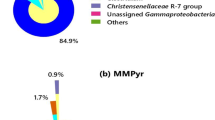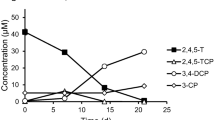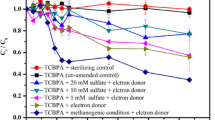Abstract
The biodegradation of phenolic compounds under sulfate-reducing conditions was studied in sediments from northern Indiana. Phenol, p-cresol and 4-chlorophenol were selected as test substrates and added to sediment suspensions from four sites at an initial concentration of 10 mg/liter. Degradative abilities of the sediment microorganisms from the four sites could be related to previous exposure to phenolic pollution. Time to onset of biodegradation of p-cresol and phenol in sediment suspensions from a nonindustrialized site was approximately 70 and 100 days, respectively, in unacclimated cultures. In sediment slurries from three sites with a history of wastewater discharges containing phenolics, time to onset of biodegradation was 50–70 days for p-cresol and 50–70 days for phenol in unacclimated cultures. In acclimated cultures from all four sites, the length of the lag phase was reduced to 14–35 days for p-cresol and 25–60 days for phenol. Length of the biodegradative phase varied from 25 to 40 days for phenol and 10 to 50 days for p-cresol and was not markedly affected by acclimation. Substrate mineralization by sulfate-reducing bacteria was confirmed with radiotracer techniques using an acclimated sediment culture from one site. Addition of molybdate, a specific inhibitor of sulfate reduction, and bacterial cell inactivation inhibited sulfate reduction and substrate utilization. None of the sites exhibited the ability to degrade 4-chlorophenol, nor were acclimated phenol and p-cresol degrading cultures from a particular site able to cometabolize 4-chlorophenol.
Similar content being viewed by others
References
American Public Health Association (1989) Standard methods for the examination of water and wastewater, 17th ed. American Public Health Association, Washington DC, pp 9–78
Banaszak KJ, Fenelon JM (1988) Water quality in a thin water-table aquifer adjacent to Lake Michigan within a highly industrialized region of Indiana. In: Hickcox DH (ed) The Great Lakes: living with North America's inland waters. American Water Resources Association, Besthesda, Md., pp 247–258
Colberg PJS (1990) Role of sulfate in microbial transformations of environmental contaminants: chlorinated aromatic compounds. Geomicrobiol J 8:147–165
Dean-Ross D (1989) Bacterial abundance and activity in hazardous waste-contaminated soil. Bull Environ Contam Toxicol 43:511–517
Dean-Ross D (1989) Bacterial community structure and function along a heavy metal gradient. Appl Environ Microbiol 55:2002–2009
Genthner BR, Price II WA, Pritchard PA (1989) Anaerobic degradation of chloroaromatic compounds in aquatic sediments under a variety of enrichment conditions. Appl Environ Microbiol 55:1466–1471
Haggblom MM, Young LY (1990) Chlorophenol degradation coupled to sulfate reduction. Appl Environ Microbiol 56:3255–3260
Haggblom MM, Rivera MD, Bossert ID, Rogers JE, Young LY (1990) Anaerobic biodegradation of para-cresol under three reducing conditions. Microbial Ecol 1990:141–150
Haggblom MM, Rivera MD, Young LY (1993) Influence of alternative electron acceptors of the anaerobic biodegadability of chlorinated phenols and benzoic acids. Appl Environ Microbiol 59:1162–1167
Ingvorsen K, Brock TD (1982) Electron flow via sulfate reduction and methanogenesis in the anaerobic hypolimnion of Lake Mendota. Limnol Oceanog 27:559–564
Kohring G-W, Zhang X, Wiegel J (1989) Anaerobic dechlorination of 2,4-dichlorophenol in freshwater sediments in the presence of sulfate. Appl Environ Microbiol 55:2735–2737
Lovley DR, Klug MJ (1983) Sulfate reducers can outcompete methanogens at freshwater sulfate concentrations. Appl Environ Microbiol 45:187–192
13. Ramanand K, Suflita JM (1991) Anaerobic degradation of m-cresol in anoxic aquifer slurries: carboxylation reactions in a sulfate-reducing bacterial enrichment. Appl Environ Microbiol 57:1689–1695
Simmers JW, Lee CR, Brandon DL, Tatem HE, Skogerboe JG (1991) Information summary, area of concern: Grand Calumet River, Indiana. Department of the Army, Waterways Experiment Station, Vicksburg, Mississippi
Smolenski WJ, Suflita JM (1987) Biodegradation of cresol isomers in anoxic aquifers. Appl Environ Microbiol 53:710–716
16. Suflita JM, Liang L, Saxena A (1989) The anaerobic biodegradation of o-, m-, and p-cresol by sulfate-reducing bacterial enrichment cultures obtained from a shallow anoxic aquifer. J Ind Microbiol 4:255–266
Tanner RS (1989) Monitoring sulfate-reducing bacteria: comparison of enumeration media. J Microbiol Methods 10:83–90
U.S. Environmental Protection Agency, Environmental Monitoring and Support Laboratory, Office of Research and Development (1983) Methods for chemial analysis of water and wastes. US Environmental Protection Agency, Washington DC
U.S. Environmental Protection Agency, Office of Solid Waste and Emergency Response (1986) Test methods for evaluation solid waste. US Environmental Protection Agency, Washington DC
Widdel F (1986) Sulfate-reducing bacteria and their ecological niches. In: Barnes EM, Mead GC (eds) Anaerobic bacteria in habitats other than man. Blackwell Scientific Publications, Oxford, pp 156–184
Young L (1987) Microbial degradation. In: Lave LB, Uton AC (eds) Toxic chemicals, health, and the environment. The Johns Hopkins University Press, Baltimore, pp 220–229
Author information
Authors and Affiliations
Additional information
Correspondence to: D. Dean-Ross
Rights and permissions
About this article
Cite this article
Mort, S.L., Dean-Ross, D. Biodegradation of phenolic compounds by sulfate-reducing bacteria from contaminated sediments. Microb Ecol 28, 67–77 (1994). https://doi.org/10.1007/BF00170248
Received:
Revised:
Issue Date:
DOI: https://doi.org/10.1007/BF00170248




